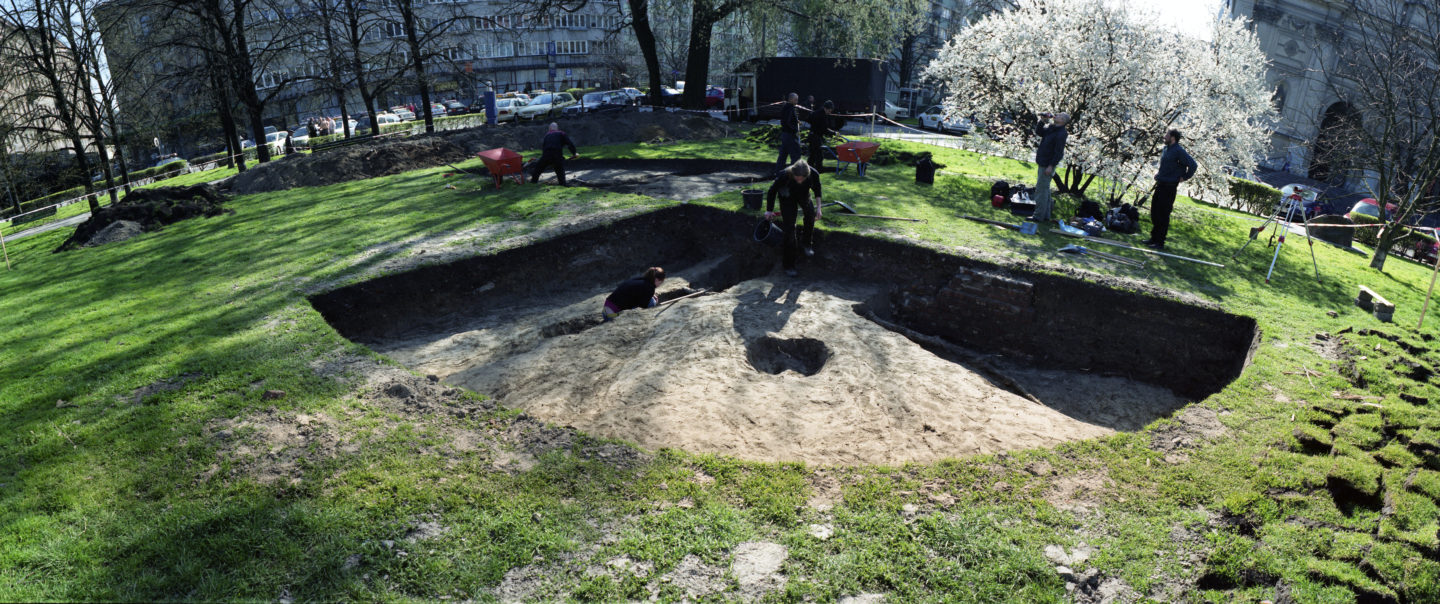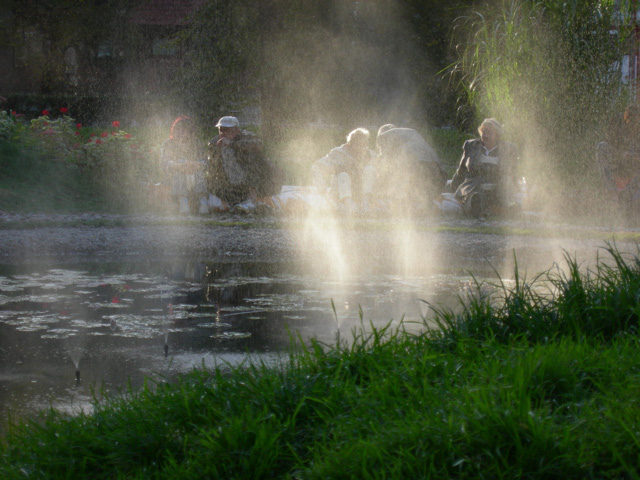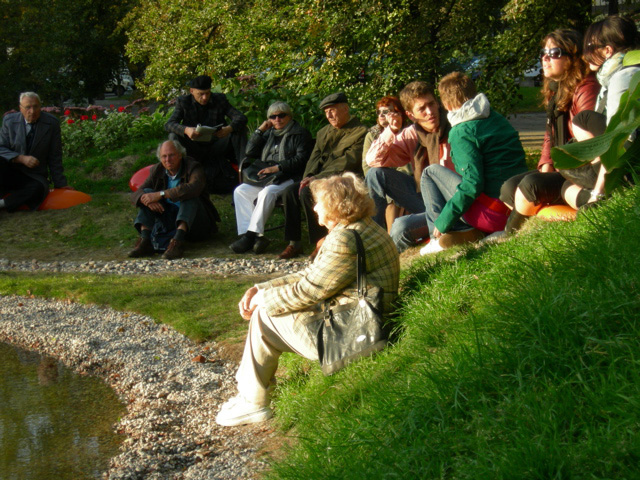Oxygenator
2007,
Joanna Rajkowka talks to Piotr Paziński
Midrasz 11/2007

Photo. Marek Szczepański
The Oxygenator pond has proved a major success. Since July, when it was opened, it has been surrounded by crowds of people who simply can’t imagine this pond not being here. Are you happy?
I am, of course. Still, with projects like this, you have to be prepared for everything.
Why this and not another location? I understand it wasn’t a random decision… Did you realise the pond would be located literally at the intersection of paths of memory, just a couple of metres from a Polish Socialist Party commemorative stone, a Pope monument, a Home Army stone, halfway between Warsaw’s sole preserved synagogue and a church known for its nationalistic sympathies…
Your question explains why the Oxygenator was made. Though I was interested not so much in paths of memory as in people’s walking paths. Which way they go, how they behave, do they come to Plac Grzybowski to sit on a bench for a while or do they just hurry across it? The gestures, the bodily positions, is what I have always been interested in.
The Oxygenator is virtually the only nice place in the area. Otherwise, Plac Grzybowski is a neglected and ugly place. Weren’t you struck by the contrast between its ugliness and its powerful emotional charge?
It seems to me that its ugliness is precisely the result of this negative, painful emotional charge. There are places we don’t know what to do with because they are more powerful than us. This power is paralysing. Such places usually lay idle because no one feels strong enough to confront them.
In one interview you called Plac Grzybowski ‘no man’s land’. A place we want to cross as quickly as possible. Is this because of its particular history, or is it simply one of many such places in Warsaw? Rondo the Gaulle’a isn’t very pretty either…
It is surely its history. And what I mean by ‘history’ is the collection of individual, personal, human tragedies. Plac Grzybowski’s ugliness is further enhanced by the presence of the Antyk Patriotic Bookstore which until last year sold anti-Semitic literature. And also by the fact that many of the local residents are people whose age and poverty have turned them into an underclass. It is them, I believe, who’ve made the Oxygenator what it is. It is in them that an incredible craving manifested itself for a place in which they could feel at home, where they could feel that they are where they should be. That they are neither too old nor too poor to sit by the Oxygenator. People are like seismographs and they sense instinctively whether a place is for them, whether they fit into a puzzle, or whether they are but a redundant piece on someone else’s game.

Warsaw is virtually overwhelmed by symbolism and martyrology. Commemorative plaques, monuments, stones can be found at every step. Most of them defying any aesthetical standards – first the socialist-realistic granite figures of WWII heroes, now the patriotic-style bronze eagles or chains, or the cheap hyperrealism of Pope or Piłsudski monuments – they enslave the public space, squeezing out the selfless, apolitical. This is how I perceive your project – as the praise of selflessness in art, in public space, and in small urban architecture. Wasn’t it one of your motives?
My motives were very much political. And, in a way, not selfless at all. What was political was the idea of mobilising people. Of giving them a pretext in the shape of a project through which they could express their views about the function of public space. That the elderly ladies spoke to the town council, collected signatures under a petition for the pond to be left in place, that, with their activity, they actually thwarted the plans for erecting the horrible monument of the victims of the Volhynia massacres – is very much political. My intention was simple – I wanted people to feel that they have the right to public space, that they can determine its fate, that they have a voice as citizens. I gave them the right, as it were, to Plac Grzybowski.
Do you think the Oxygenator has provoked any wider debate on Warsaw’s public space? Or at least on what to do with Warsaw, how to make it a better place to be and for whom?
This is something I don’t know because the debates just go on and on and nothing comes out of them. So I don’t visit the forums too often.
You’ve watched people’s reactions. How do they differ? Do the Israelis react differently to the pond, the people attending Sunday service at the All Saints’ church differently, and the local winos differently? Or perhaps the Oxygenator has united them all?
The homeless kept order, the old ladies too. This much I know from observation and from other people’s accounts. A vast majority of people simply sat there in a very casual atmosphere, some actually took a nap. This was charming because I can’t think of anything more defenceless. Some said the pond was too close to the church, others said it was too close to the synagogue… I wouldn’t say the Oxygenator had a unifying effect. It simply allowed people to be in the same place, physically close to each other, without the need for making compromises or offering explanations. It was no longer important why someone came and from where. The differences of opinion, personal histories, traumas, got somewhat suspended. What mattered was the moment of being-towards-each-other. This is how I’ve called it for my own purposes.

And if it did unite people, after all, if it shocked them – then for how long? How much is there of utopia in this pond, and how much of practical thinking: with just a bit of effort we can improve the space around us.
I will ignore the first part of the question because I think that it neither united nor shocked. The Oxygenator is utopia fulfilled. It is a kind of mirage that works only for a moment. At the same time, it is a very effective mirage with tangible physical effects – the example of a reality where the differences between people don’t lead to conflict but create enriching variety. This is an inclusive reality – it allows people, as they are, to be together and feel fully entitled to the given space.
You said you were a fan of organic cities. How to make Warsaw organic again? Is it possible at all? How many palm trees would have to be planted, how many ponds dug up?
I don’t know, I’m an expert on mirages.
Or perhaps it’s so that neither the Oxygenator nor the palm are organic at all? They are just curiosities that will remain in place until the residents get bored with them. Then they will treat them like they treat any other artistic whim and deny their support for them?
It depends on what you mean by organic. They’re certainly not an organic part of the city but rather a surreal vision that people want because they see their own craving reflected in them. As long as they continue to crave, my projects will have a reason to exist.
Aren’t you afraid that one day the empty basin of the pond becomes but a garbage dump, the disintegrated people return to their homes, and life on Plac Grzybowski returns to norm?
No, I’m not.
Joanna Rajkowska talked to Piotr Pazinski
Translated by Marcin Wawrzyńczak